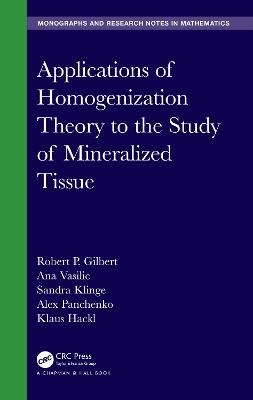
Applications of Homogenization Theory to the Study of Mineralized Tissue
Chapman & Hall/CRC (Verlag)
978-1-58488-791-1 (ISBN)
Homogenization is a fairly new, yet deep field of mathematics which is used as a powerful tool for analysis of applied problems which involve multiple scales. Generally, homogenization is utilized as a modeling procedure to describe processes in complex structures.
Applications of Homogenization Theory to the Study of Mineralized Tissue functions as an introduction to the theory of homogenization. At the same time, the book explains how to apply the theory to various application problems in biology, physics and engineering.
The authors are experts in the field and collaborated to create this book which is a useful research monograph for applied mathematicians, engineers and geophysicists. As for students and instructors, this book is a well-rounded and comprehensive text on the topic of homogenization for graduate level courses or special mathematics classes.
Features:
Covers applications in both geophysics and biology.
Includes recent results not found in classical books on the topic
Focuses on evolutionary kinds of problems; there is little overlap with books dealing with variational methods and T-convergence
Includes new results where the G-limits have different structures from the initial operators
Robert P. Gilbert is a Unidel Professor of Mathematics at the University of Delaware and has authored numerous papers and articles for journals and conferences. He is also a founding editor of Complex Variables and Applicable Analysis and serves on many editorial boards. His current research involves the area of inverse problems, homogenization and the flow of viscous fluids. Ana Vasilic is an associate professor of mathematics at Northern New Mexico College. She has contributed to mathematical publications such as Mathematical and Computer Modeling and Applicable Analysis. Her research interests include applied analysis, partial differential equations, homogenization and multiscale problems in porous media. Sandra Klinge is an assistant professor in computational mechanics at Technische Universitat, Dortmund, Germany. She has written several articles for science journals and contributed to many books. Homogenization, modeling of polymers and multiscale modeling are among her research interests. Alex Panchenko is a professor of mathematics at Washington State University and has written for several publications, many of which are collaborations with Robert Gilbert. These include journals such as SIAM Journal Math. Analysis and Mathematical and Computer Modeling. Klaus Hackl is a professor of mechanics at Ruhr-Universitat Bochum, Germany and has made many scholarly contributions to various journals. His research interests include continuum mechanics, numerical mechanics, modeling of materials and multiscale problems.
Introductory Remarks
Some Functional Spaces
Variational Formulation
Geometry of Two Phase Composite
Two-scale Convergence Method
The Concept of a Homogenized Equation
Two-Scale convergence with time dependence
Potential and Solenoidal Fields
The Homogenization Technique Applied to Soft Tissue
Homogenization of Soft Tissue
Galerkin approximations
Derivation of the effective equation of U0
Acoustics in Porous Media
Introduction
Diphasic Macroscopic Behavior
Well-posedness for problem (3.2.49 and 3.2.55)
The slightly compressible di-phasic behavior
Wet Ionic, Piezo-electric Bone
Introduction
Wet bone with ionic interaction
Homogenization using Formal Power Series
Wet bone without ionic interaction
Electrodynamics
Visco-elasticity and Contact Friction Between the Phases
Kelvin-Voigt Material
Rigid Particles in a Visco-elastic Medium
Equations of motion and contact conditions
Two-scale expansions and formal homogenization
Model case I: Linear contract conditions
Model case II: Quadratic contract conditions
Model case III: Power type contact condition
Acoustics in a Random Microstructure
Introduction
Stochastic Two-scale limits
Periodic Approximation
Non-Newtonian Interstitial Fluid
The Slightly Compressible Polymer. Microscale Problem
A Priori Estimates
Two-Scale System
Description of the effective stress
Effective equations
Multiscale FEM for the modeling of cancellous bone
Concept of the multiscale FEM
Microscale: Modeling of the RVE and calculation of the effective material properties
Macroscale: Simulation of the ultrasonic test
Simplified version of the RVE and comparison with the experimental results
Anisotropy of cancellous bone
Investigation of the influence of reflection on the attenuation of cancellous bone
Determination of the geometry of the RVE for cancellous bone by using the effective complex shear modulus
G-convergence and Homogenization of Viscoelastic Flows
Introduction
Main definitions. Corrector operators for G-convergence
A scalar elliptic equation in divergence form
Homogenization of two-phase visco-elastic flows with time-varying interface
Main theorem and outline of the proof
Corrector operators and oscillating test functions
Inertial terms in the momentum balance equation
Effective deviatoric stress. Proof of the main theorem
Fluid-structure interaction
Biot Type Models for Bone Mechanics
Bone Rigidity
Anisotropic Biot Systems
The Case of a non-Newtonian Interstitial Fluid
Some Time-Dependent Solutions to the Biot System
Creation of RVE for Bone Microstructure
The RVE Model
Reformulation as a Graves-like scheme
Absorbring boundary condition-perfectly matched layer
Discretized systems
Bone Growth and Adaptive Elasticity
The Model
Scalings of Unknowns
Asymptotic Solutions
Further Reading
| Erscheint lt. Verlag | 29.12.2020 |
|---|---|
| Reihe/Serie | Chapman & Hall/CRC Monographs and Research Notes in Mathematics |
| Zusatzinfo | 2 Tables, black and white; 40 Illustrations, black and white |
| Sprache | englisch |
| Maße | 156 x 234 mm |
| Gewicht | 562 g |
| Themenwelt | Mathematik / Informatik ► Mathematik ► Analysis |
| ISBN-10 | 1-58488-791-5 / 1584887915 |
| ISBN-13 | 978-1-58488-791-1 / 9781584887911 |
| Zustand | Neuware |
| Haben Sie eine Frage zum Produkt? |
aus dem Bereich


